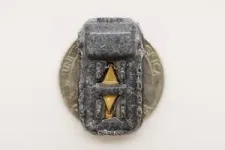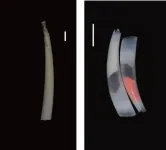(Press-News.org) CAMBRIDGE, MA -- One promising approach to treating Type 1 diabetes is implanting pancreatic islet cells that can produce insulin when needed, which can free patients from giving themselves frequent insulin injections. However, one major obstacle to this approach is that once the cells are implanted, they eventually run out of oxygen and stop producing insulin.
To overcome that hurdle, MIT engineers have designed a new implantable device that not only carries hundreds of thousands of insulin-producing islet cells, but also has its own on-board oxygen factory, which generates oxygen by splitting water vapor found in the body.
The researchers showed that when implanted into diabetic mice, this device could keep the mice’s blood glucose levels stable for at least a month. The researchers now hope to create a larger version of the device, about the size of a stick of chewing gum, that could eventually be tested in people with Type 1 diabetes.
“You can think of this as a living medical device that is made from human cells that secrete insulin, along with an electronic life support-system. We’re excited by the progress so far, and we really are optimistic that this technology could end up helping patients,” says Daniel Anderson, a professor in MIT’s Department of Chemical Engineering, a member of MIT’s Koch Institute for Integrative Cancer Research and Institute for Medical Engineering and Science (IMES), and the senior author of the study.
While the researchers’ main focus is on diabetes treatment, they say that this kind of device could also be adapted to treat other diseases that require repeated delivery of therapeutic proteins.
MIT Research Scientist Siddharth Krishnan is the lead author of the paper, which appears today in the Proceedings of the National Academy of Sciences. The research team also includes several other researchers from MIT, including Robert Langer, the David H. Koch Institute Professor at MIT and a member of the Koch Institute, as well as researchers from Boston Children’s Hospital.
Replacing injections
Most patients with Type 1 diabetes have to monitor their blood glucose levels carefully and inject themselves with insulin at least once a day. However, this process doesn’t replicate the body’s natural ability to control blood glucose levels.
“The vast majority of diabetics that are insulin-dependent are injecting themselves with insulin, and doing their very best, but they do not have healthy blood sugar levels,” Anderson says. “If you look at their blood sugar levels, even for people that are very dedicated to being careful, they just can’t match what a living pancreas can do.”
A better alternative would be to transplant cells that produce insulin whenever they detect surges in the patient’s blood glucose levels. Some diabetes patients have received transplanted islet cells from human cadavers, which can achieve long-term control of diabetes; however, these patients have to take immunosuppressive drugs to prevent their body from rejecting the implanted cells.
More recently, researchers have shown similar success with islet cells derived from stem cells, but patients who receive those cells also need to take immunosuppressive drugs.
Another possibility, which could prevent the need for immunosuppressive drugs, is to encapsulate the transplanted cells within a flexible device that protects the cells from the immune system. However, finding a reliable oxygen supply for these encapsulated cells has proven challenging.
Some experimental devices, including one that has been tested in clinical trials, feature an oxygen chamber that can supply the cells, but this chamber needs to be reloaded periodically. Other researchers have developed implants that include chemical reagents that can generate oxygen, but these also run out eventually.
The MIT team took a different approach that could potentially generate oxygen indefinitely, by splitting water. This is done using a proton-exchange membrane — a technology originally deployed to generate hydrogen in fuel cells — located within the device. This membrane can split water vapor (found abundantly in the body) into hydrogen, which diffuses harmlessly away, and oxygen, which goes into a storage chamber that feeds the islet cells through a thin, oxygen-permeable membrane.
A significant advantage of this approach is that it does not require any wires or batteries. Splitting this water vapor requires a small voltage (about 2 volts), which is generated using a phenomenon known as resonant inductive coupling. A tuned magnetic coil located outside the body transmits power to a small, flexible antenna within the device, allowing for wireless power transfer. It does require an external coil, which the researchers anticipate could be worn as a patch on the patient’s skin.
Drugs on demand
After building their device, which is about the size of a U.S. quarter, the researchers tested it in diabetic mice. One group of mice received the device with the oxygen-generating, water-splitting membrane, while the other received a device that contained islet cells without any supplemental oxygen. The devices were implanted just under the skin, in mice with fully functional immune systems.
The researchers found that mice implanted with the oxygen-generating device were able to maintain normal blood glucose levels, comparable to healthy animals. However, mice that received the nonoxygenated device became hyperglycemic (with elevated blood sugar) within about two weeks.
Typically when any kind of medical device is implanted in the body, attack by the immune system leads to a buildup of scar tissue called fibrosis, which can reduce the devices’ effectiveness. This kind of scar tissue did form around the implants used in this study, but the device’s success in controlling blood glucose levels suggests that insulin was still able to diffuse out of the device, and glucose into it.
This approach could also be used to deliver cells that produce other types of therapeutic proteins that need to be given over long periods of time. In this study, the researchers showed that the device could also keep alive cells that produce erythropoietin, a protein that stimulates red blood cell production.
“We’re optimistic that it will be possible to make living medical devices that can reside in the body and produce drugs as needed,” Anderson says. “There are a variety of diseases where patients need to take proteins exogenously, sometimes very frequently. If we can replace the need for infusions every other week with a single implant that can act for a long time, I think that could really help a lot of patients.”
The researchers now plan to adapt the device for testing in larger animals and eventually humans. For human use, they hope to develop an implant that would be about the size of a stick of chewing gum. They also plan to test whether the device can remain in the body for longer periods of time.
“The materials we’ve used are inherently stable and long-lived, so I think that kind of long-term operation is within the realm of possibility, and that’s what we’re working on,” Krishnan says.
“We are very excited about these findings, which we believe could provide a whole new way of someday treating diabetes and possibly other diseases,” Langer adds.
###
The research was funded by JDRF, the Leona M. and Harry B. Helmsley Charitable Trust, and the National Institute of Biomedical Imaging and Bioengineering at the National Institutes of Health.
END
An implantable device could enable injection-free control of diabetes
The device contains encapsulated cells that produce insulin, plus a tiny oxygen-producing factory that keeps the cells healthy.
2023-09-18
ELSE PRESS RELEASES FROM THIS DATE:
Buried ancient Roman glass formed substance with modern applications
2023-09-18
Some 2,000 years ago in ancient Rome, glass vessels carrying wine or water, or perhaps an exotic perfumes, tumble from a table in a marketplace, and shatter to pieces on the street. As centuries passed, the fragments were covered by layers of dust and soil and exposed to a continuous cycle of changes in temperature, moisture, and surrounding minerals.
Now these tiny pieces of glass are being uncovered from construction sites and archaeological digs and reveal themselves to be something extraordinary. On their surface is a mosaic of iridescent colors of blue, green and orange, with some displaying shimmering gold-colored ...
Genomes of enigmatic tusk shells provide new insights into early Molluscan evolution
2023-09-18
Accurate phylogenetic trees are fundamental to evolutionary and comparative biology, but the almost simultaneous emergence of major animal phyla and diverse body plans during the Cambrian Explosion poses major challenges to reconstructing deep metazoan phylogenetic relationships.
This is particularly true for the second largest phylum, Mollusca, whose major lineages originated in the Cambrian period. The diverse fossil record, extreme morphological disparity among the eight living classes, and dramatic conflict among phylogenetic hypotheses due to diverse paleontological, ...
Remote work can slash your carbon footprint — if done right
2023-09-18
ITHACA, N.Y. – Remote workers can have a 54% lower carbon footprint compared with onsite workers, according to a new study by Cornell University and Microsoft, with lifestyle choices and work arrangements playing an essential role in determining the environmental benefits of remote and hybrid work.
The study, published in the Proceedings of the National Academy of Sciences, also finds that hybrid workers who work from home two to four days per week can reduce their carbon footprint by 11% to 29%, but working from home one day per week ...
Preschoolers from low-income families may have worse health and benefit less from health promotion interventions than children with higher socioeconomic status
2023-09-18
Low socioeconomic status can negatively impact children’s health in preschool, along with their ability to follow specialized health education intervention programs, Mount Sinai researchers found in an international study focused on health promotion in schools, including those in the Harlem section of New York City. The results, published September 18 in the Journal of American College of Cardiology, stress the importance of introducing a specialized health curriculum in classrooms starting in preschool.
“This study shows that socioeconomic factors, including lower household income and education level, can negatively impact children’s health starting ...
Oregon State receives $7.5 million grant to build state of the art zebrafish biomedical research facility
2023-09-18
CORVALLIS, Ore. – Oregon State University has received a $7.5 million National Institutes of Health grant to modernize a lab focused on using zebrafish to address pressing human health challenges.
The Sinnhuber Aquatic Research Laboratory, led by Distinguished Professor Robyn Tanguay, a molecular toxicologist in the College of Agricultural Sciences, exploits the unique advantages of zebrafish to protect and improve human and environmental health. Zebrafish and humans have similar developmental processes and are similar on a genomic level, ...
Employee surveys may miss out on uncovering toxic leadership practices
2023-09-18
BINGHAMTON, N.Y. -- Standardized and overly simplistic questionnaires are only scratching the surface of what employees think of their leaders, according to new research from Binghamton University’s School of Management (SOM), and negative behavior may be slipping through the cracks.
As a result, the research finds, organizations may be missing out on critical information that could be keeping toxic leaders in positions of power.
“Instead of capturing actual leader behaviors, ratings might simply reflect whether a person likes their leader,” said Mengying ...
Key to solving Libyan conflict lies within the country, analysis says
2023-09-18
The key to solving the Libyan political conflict lies within the country rather than with the international community, analysis says.
Electoral and governance deadlock has been blamed for the devastating impact of the flooding in the country.
The “contentment” of the political elite and others with the status quo - given the currently limited levels of violence and the rising global prices of energy since the outbreak of Russia’s war on Ukraine - explains the general lack of a genuine commitment to relaunch the transition and electoral roadmap, ...
Personalized combination treatment turns on an immunometabolic switch to effectively control an aggressive form of prostate cancer
2023-09-18
Researchers at the University of Chicago Medicine Comprehensive Cancer Center established “proof-of-concept” for a new treatment approach that was able to effectively treat the most aggressive forms of prostate cancer. The treatment showed complete tumor control and long-lasting survival without side effects in a mouse model of advanced prostate cancer.
These findings, which were published online September 18, 2023, in Clinical Cancer Research, warrant further investigation in human clinical trials, the researchers concluded.
Strategies to overcome resistance
“Prostate cancer in the metastatic ...
Power meals: Child care-provided meals are associated with improved child and family health
2023-09-18
Philadelphia, September 18, 2023 – Very young children who attend child care and receive onsite meals and snacks were more likely to be food secure and in good health, and less likely to be admitted after a hospital emergency department visit than children in child care whose meals and snacks were provided from home, according to a new study in the Journal of the Academy of Nutrition and Dietetics, published by Elsevier. These potential benefits could extend beyond the children themselves to their families, including through possible reductions in stress, and to society as a whole through potentially significant healthcare cost savings.
Lead author Stephanie ...
DOE backs Rice study of how soils store carbon
2023-09-18
HOUSTON – (Sept. 18, 2023) – Two Rice University scientists have received a 3-year grant from the Department of Energy (DOE) to investigate a form of carbon storage that is as little understood as it is ubiquitous: soil.
Mark Torres, an assistant professor of Earth, environmental and planetary sciences, and Evan Ramos, a postdoctoral fellow in the Torres lab, will track how key minerals form in a watershed to build a fuller picture of the processes that allow soil to store carbon as organic matter.
“Soil on Earth contains three times more carbon than the atmosphere,” Ramos said. “We ...
LAST 30 PRESS RELEASES:
Making lighter work of calculating fluid and heat flow
Normalizing blood sugar can halve heart attack risk
Lowering blood sugar cuts heart attack risk in people with prediabetes
Study links genetic variants to risk of blinding eye disease in premature infants
Non-opioid ‘pain sponge’ therapy halts cartilage degeneration and relieves chronic pain
AI can pick up cultural values by mimicking how kids learn
China’s ecological redlines offer fast track to 30 x 30 global conservation goal
Invisible indoor threats: emerging household contaminants and their growing risks to human health
Adding antibody treatment to chemo boosts outcomes for children with rare cancer
Germline pathogenic variants among women without a history of breast cancer
Tanning beds triple melanoma risk, potentially causing broad DNA damage
Unique bond identified as key to viral infection speed
Indoor tanning makes youthful skin much older on a genetic level
Mouse model sheds new light on the causes and potential solutions to human GI problems linked to muscular dystrophy
The Journal of Nuclear Medicine ahead-of-print tip sheet: December 12, 2025
Smarter tools for peering into the microscopic world
Applications open for funding to conduct research in the Kinsey Institute archives
Global measure underestimates the severity of food insecurity
Child survivors of critical illness are missing out on timely follow up care
Risk-based vs annual breast cancer screening / the WISDOM randomized clinical trial
University of Toronto launches Electric Vehicle Innovation Ontario to accelerate advanced EV technologies and build Canada’s innovation advantage
Early relapse predicts poor outcomes in aggressive blood cancer
American College of Lifestyle Medicine applauds two CMS models aligned with lifestyle medicine practice and reimbursement
Clinical trial finds cannabis use not a barrier to quitting nicotine vaping
Supplemental nutrition assistance program policies and food insecurity
Switching immune cells to “night mode” could limit damage after a heart attack, study suggests
URI-based Global RIghts Project report spotlights continued troubling trends in worldwide inhumane treatment
Neutrophils are less aggressive at night, explaining why nighttime heart attacks cause less damage than daytime events
Menopausal hormone therapy may not pose breast cancer risk for women with BRCA mutations
Mobile health tool may improve quality of life for adolescent and young adult breast cancer survivors
[Press-News.org] An implantable device could enable injection-free control of diabetesThe device contains encapsulated cells that produce insulin, plus a tiny oxygen-producing factory that keeps the cells healthy.








